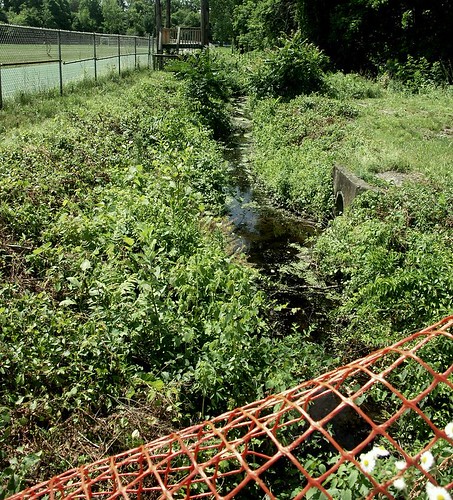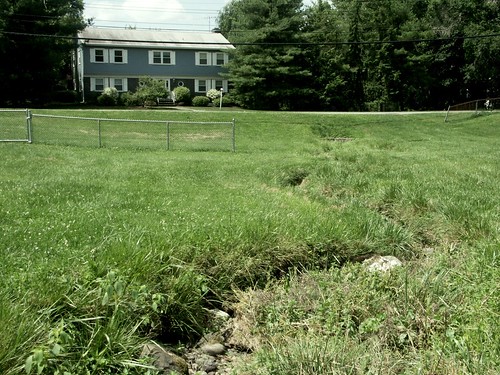The Hidden Spackenkill Creek
June 25, 2010 by admin
The Spackenkill was once a very small watershed adjacent to the Casperkill watershed. Today, the headwaters of the Spackenkill creek are actually within the Casperkill watershed. The picture above shows the dry creek bed leading up to Hagan Drive.
While Nadine and I interviewed Fran Hartenfels about her experience living along the Casperkill, Fran’s friend Michelle McGinnis stopped by. Fran told us that Michelle lived nearby, and that a creek also went through Michelle’s backyard…
Fran: What do they call it? A kill or whatever.
Michelle: A drainage ditch?
Fran: No. It’s part of the watershed. (Turning to me and Nadine) What do they call it?
Michelle: It’s a drainage ditch, not a watershed!
Fran: No, honey, it’s not a drainage ditch!”
According to Michelle, a homeowner living along Pasture Lane, the Spackenkill creek only really has water in it when it rains. The rest of the year the creek-bed is mostly mud with only an occasional trickle of water.
Although the creek might seem like a drainage ditch most of the time, three or four times a year there are rainstorms big enough to cause the ponds at the McCann Golf Course to overflow. The Spackenkill swells so much that it floods Hagan Drive and pours into the (usually dry) creek bed between Miron Drive and Pasture Lane. This deluge brings tennis balls from the Spackenkill High School courts and a whole host of other do-dads and trash articles into nearby backyards. Michelle told us that when her children were young, they used to fish for trout in the creek and put on floaters to “run the rapids.”
Michelle’s story reminds us that even though the Spackenkill is usually inconspicuous, it is still an important resource that we should seek to draw attention to and protect. The Spackenkill and other tributaries of the Hudson River are often very hard to detect. Without consulting maps and other resources even trained scientific researchers have a difficult time differentiating between what we might consider “drainage ditches” and tributaries. One important thing to keep in mind when attempting to tell the difference, is that the distinction is actually less important than it might seem. Even things that we traditionally think about as “drainage ditches” all eventually empty into our streams, and ultimately into the Hudson River. Poughkeepsie gets its drinking water from the Hudson, so it is important to try to prevent trash, chemicals, and other harmful things from entering any waterway.

The Spackenkill flowing alongside the Spackenkill High School track.
Photo credit: Nadine Souto
